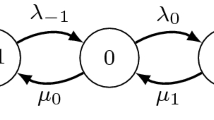Abstract
Continuous-time birth-death Markov processes serve as useful models in population biology. When the birth-death rates are nonlinear, the time evolution of the first n order moments of the population is not closed, in the sense that it depends on moments of order higher than n. For analysis purposes, the time evolution of the first n order moments is often made to be closed by approximating these higher order moments as a nonlinear function of moments up to order n, which we refer to as the moment closure function.
In this paper, a systematic procedure for constructing moment closure functions of arbitrary order is presented for the stochastic logistic model. We obtain the moment closure function by first assuming a certain separable form for it, and then matching time derivatives of the exact (not closed) moment equations with that of the approximate (closed) equations for some initial time and set of initial conditions. The separable structure ensures that the steady-state solutions for the approximate equations are unique, real and positive, while the derivative matching guarantees a good approximation, at least locally in time. Explicit formulas to construct these moment closure functions for arbitrary order of truncation n are provided with higher values of n leading to better approximations of the actual moment dynamics.
A host of other moment closure functions previously proposed in the literature are also investigated. Among these we show that only the ones that achieve derivative matching provide a close approximation to the exact solution. Moreover, we improve the accuracy of several previously proposed moment closure functions by forcing derivative matching.
Similar content being viewed by others
References
Bailey, N.T.J., 1964. The Elements of Stochastic Processes. Wiley, New York.
Feller, W., 1939. Die grundlagen der volterraschen theorie des kampfes ums dasein in wahrscheinlichkeitstheoretischer behandlung. Acta Biotheor. 5, 11–40.
Hespanha, J.P., 2004. Stochastic hybrid systems: applications to communication networks. In: Alur, R., Pappas, G.J. (Eds.), Hybrid Systems: Computation and Control. Lect. Notes in Comput. Science, vol. 2993, pp. 387–401. Springer, Berlin.
Hespanha, J.P., Singh, A., 2005. Stochastic models for chemically reacting systems using polynomial stochastic hybrid systems. Int. J. Robust Nonlinear Control 15, 669–689.
Keeling, M.J., 2000. Multiplicative moments and measures of persistence in ecology. J. Theor. Biol. 205, 269–281.
Krishnarajah, I., Cook, A., Marion, G., Gibson, G., 2005. Novel moment closure approximations in stochastic epidemics. Bull. Math. Biol. 67, 855–873.
Matis, J.H., Kiffe, T.R., 1996. On approximating the moments of the equilibrium distribution of a stochastic logistic model. Biometrics 52, 980–991.
Matis, J.H., Kiffe, T.R., 2002. On interacting bee/mite populations: a stochastic model with analysis using cumulant truncation. Environ. Ecol. Stat. 9, 237–258.
Matis, J.H., Kiffe, T.R., Parthasarathy, P.R., 1998. On the cumulant of population size for the stochastic power law logistic model. Theor. Popul. Biol. 53, 16–29.
Nåsell, I., 2001. Extinction and quasi-stationarity in the verhulst logistic model. J. Theor. Biol. 211, 11–27.
Nåsell, I., 2003a. An extension of the moment closure method. Theor. Popul. Biol. 64, 233–239.
Nåsell, I., 2003b. Moment closure and the stochastic logistic model. Theor. Popul. Biol. 63, 159–168.
Pearl, R., Reed, L.J., 1920. On the rate of growth of the population of the united states since 1790 and its mathematical representation. Proc. Nat. Acad. Sci. USA 6, 275–288.
Pielou, E.C., 1977. Mathematical Ecology. Wiley, New York.
Singh, A., & Hespanha, J.P., 2006. Moment closure for the stochastic logistic model. Tech. Rep. CCEC-06-0117, Center for Control, Dynamical Systems and Computation. University of California at Santa Barbara, available at http://www.ece.ucsb.edu/~hespanha/techrep.html.
Verhulst, P.F., (1838). Notice sur la loi que la population suit dans son accroissement. Corresp. Math. Phys. 10, 113–121.
Whittle, P., 1957. On the use of the normal approximation in the treatment of stochastic processes. J. Roy. Stat. Soc. Ser. B 19, 268–281.
Author information
Authors and Affiliations
Corresponding author
Rights and permissions
About this article
Cite this article
Singh, A., Hespanha, J.P. A Derivative Matching Approach to Moment Closure for the Stochastic Logistic Model. Bull. Math. Biol. 69, 1909–1925 (2007). https://doi.org/10.1007/s11538-007-9198-9
Received:
Accepted:
Published:
Issue Date:
DOI: https://doi.org/10.1007/s11538-007-9198-9




